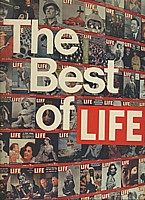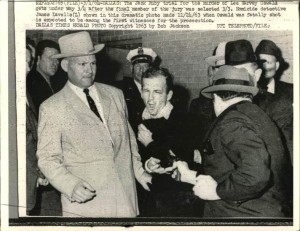On 24 November 1963 my father Jack Spackman was working on The Telegraph in Sydney when he experienced what he described as one of his most exciting moments as a journalist. It was close to deadline and the front page story was to be the latest dramatic twist in the events sparked two days earlier when a gunman, crouched in a sixth-floor window, fired the shots which still reverberate more than 50 years later.
That gunman, Lee Harvey Oswald, was now dead in turn – shot by Jack Ruby, a nightclub operator from Chicago, as he was being transferred to the county jail.
“The picture editor sent me down to the wireroom to see what was coming through,” Jack said. What was coming through, line by painfully slow line, was the iconic picture taken on 24 November, 1963 by Robert H. Jackson, news photographer for the Dallas Times Herald.
“I called up to the picture desk and got a bark of ‘Well? What have you got?’ I told him, ‘I’m looking at Jack Ruby sticking a gun in Oswald’s guts.’ All I heard on the other end was ‘Bullshit.’
“And next thing I knew he was standing at my shoulder, all red in the face from running. I don’t think he’d ever moved so fast.
“By the time it finished coming through – and it took a good 20 minutes – there was a crush round the machine. Everyone had dropped what they were doing.”
Jackson recalled taking the shot at the same moment Ruby took his – a classic example of being in the right place at the right time.
His description of rushing the still-wet print to the wire machine is a nice counterpoint to Dad’s experience at the other end.
Acclaimed photojournalist Tim Page recently recalled the struggle to get his pictures out of war-torn Vietnam with limited and unreliable phone lines, bribes to be paid and hoops to be jumped through, all for the sake of getting, at best, three pictures down the wire.
And he too diced with the volatile combination of water and electricity by slapping his wet prints on the drum to get them out while the connection held.
In a news sense, the Oswald picture was a huge redemption for Jackson who had missed the killing of Kennedy from his vantage point in the motorcade for the mundane reason that he was handing a roll of film to a courier at the time.
The enduring images of those fateful moments were captured by an amateur with a home movie camera.
So who won the picture wars of Dallas 1963 – Zapruder or Jackson?
For me, it’s Jackson and the picture editor – possibly Jackson himself – who cropped in tight to make it all gun, guts and grimace at the moment of death.
It’s a great, Pulitzer-winning picture and you can be sure it ran big on newspaper front pages around the world.
For my father it represented everything he loved about journalism, the classic ‘hold the front page’ moment that every boy and girl reporter dreams of.
 He showed it to me in a book which became another of my childhood favourites, a collection of photographs from Life Magazine from 1937 to 1972.
He showed it to me in a book which became another of my childhood favourites, a collection of photographs from Life Magazine from 1937 to 1972.
They were the Henry Luce years, who turned Life into a weekly all-photographic news magazine and consequently shaped Little Sally’s understanding of modern history.
The Jackson picture gets a page in the book. The crucial frames of the Zapruder film a third of a page, even though the killing of the president was undoubtedly the bigger event.
That’s the power of a great photograph.
These days any number of people on the scene would have whipped out their smartphones and beamed their versions of events across the world before an old-style picture editor could shout ‘bullshit.’
But only a lucky few, whether amateur or professional, would be standing in just the right place at just the right moment, taking just the right shot.
But, as the tight crop on the Jackson picture shows, the process of making a great photograph doesn’t end there.
Leafing through the pages of The Best of Life I’m struck by how many of its images are burned into my memory forever, shortcuts to the events of history.
The anniversary of the making of one of those images, seems a very good day to celebrate photojournalism. It’s a profession which, like its written sibling, is suffering in the internet age as Girl and Boy Reporters are armed with iPhones and a crash course in photography basics if they’re lucky.
Meanwhile, war photographers, who serve on our behalf at the frontline of history, are finding it increasingly difficult to make a living as news outlets outsource the expense and the risks by taking images from often unpaid, uninsured freelancers.
There’s a tumblr for photographers which documents the day-to-day struggles of smudgers to get paid which you can read via photojournalism blog A Photo Editor here.
French newspaper Le Liberation caused a visual shock on 14 November 2013 – just before the 50th anniversary of the Jackson picture of – when it published a special edition with stark white holes instead of pictures to highlight the importance of photography.
The occasion was the opening day of the international photographic art fair Paris Photo and Liberation described its decision, not as a wake for photojournalism, but “the homage it deserves” at a time when press photographers find themselves in a “calamitous situation.”
You can see shots of the special issue here, courtesy of the British Journal of Photography.
At a time when every man, woman and their dog has a camera we’re bombarded with images as never before.
But the ones which stick in the mind, the pictures which tell the stories of a thousand words in a single frozen frame, for those you still need a photographer.
Further reading:
Peter Watson, the BBC journalist who reported from Dallas after JFK’s death, died just before the 50th anniversary of that event. Here are his raw notes from the time:
Reporting JFK’s assassination: A BBC correspondent’s notes – BBC News Magazine
A report from The New York Times in 1907 on the invention of the ‘telephotograph’ machine by Dr Arthur Korn, Professor of Physics at Munich University.
What’s most striking is the predictions Dr Korn’s invention inspired and how long it took to realise them. The article even foretells the ‘dong-shot,’ or, as the writer puts it, “lovers conversing at a great distance… (who) … may indeed behold each other as in the flesh.”
The death of photojournalism as a respected, and paid, profession was unforeseen:
Sending photographs by telegraph – The New York Times, 1907


Great post Sally! Fascinating insights into the great moments in history from a front row seat – I envy you. Hopefully, you’ll write a few more and publish them in a hard-copy collection. A must for every history buff and journalism aspirant.
ps. Hope you got a few referral hits on your last post ‘My spies’ from The Mugwump Post site.
LikeLike
Posted by edward eastwood | November 24, 2013, 1:19 pmThank you Edward! For the encouragement, the rather excellent idea… and the gratuitous spruiking. You’re a gem.
LikeLike
Posted by Sally Baxter | November 24, 2013, 1:43 pmMore like a rough diamond I fear but thanks for the compliment. Look forward to next post
LikeLike
Posted by edward eastwood | November 24, 2013, 2:03 pmLike everything else, technology has rendered great photojournalism the stuff of history. Thanks for reminding us.
What amazes me now is not the stuff of history but the way my lousy holiday snaps stored in iphoto are automatically cropped and floated on my Apple TV screen so they look like something from the National Geographic. And therein likes the rub for the professional photographer. Technology let’s us make-believe we are brilliant because we can press a button. When everyone is brilliant, when anyone can photoshop, what chance for the skilled professional? Like the difference between being able use an abacus and a digital calculator — who cares about the abacus? A pity, but there you have it.
LikeLike
Posted by yellowbrickbooks | January 14, 2014, 3:48 pm